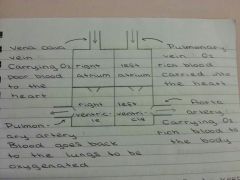![]()
![]()
![]()
Use LEFT and RIGHT arrow keys to navigate between flashcards;
Use UP and DOWN arrow keys to flip the card;
H to show hint;
A reads text to speech;
24 Cards in this Set
- Front
- Back
|
What is blood used for? |
To transport materials around your body and to protect you against disease. |
|
|
How much blood do you have in your body? |
5.5 litres. |
|
|
What do red blood cells do? |
They carry oxygen. |
|
|
What do white blood cells do? |
They fight disease. |
|
|
What does the plasma do? |
They carry blood cells, digested food, waste products (Co2), hormones and antibodies. |
|
|
What are platelets? |
They are fragments of cells that help the blood to clot. |
|
|
What are phagocytes? |
They engulf pathogens (a disease causing organism) |
|
|
What are lymphocytes? |
They produce anti-bodies, which are proteins that help remove viruses and bacteria. |
|
|
What is plasma mostly made out of? |
Water and other substances dissolved in it, like digested food and waste substances such as carbon dioxide and urea. |
|
|
What is the appearance of a red blood cell? |
They're biconcave, which creates a large surface area for gas exchange. They also have a large surface area compared to volume, so oxygen is always close to the surface. |
|
|
What pigment do red blood cells contain? |
Haemoglobin which combines with oxygen to create oxyhaemoglobin |
|
|
What two types of valves do you have in your heart? |
Atrioventricular valves (seperates the atrium from the ventricle) and semilunar valves (seperates the ventricle from the arteries). |
|
|
What does the diagram of the heart look like? |

|
|
|
Why does the heart have valves? |
To keep blood flowing in one direction. |
|
|
What side has the O2 rich blood? |
The left. |
|
|
Which side has the O2 poor blood? |
The right. |
|
|
What is the equation for aerobic respiration? |
Glucose + Oxygen > Carbon Dioxide + Water (+ energy) |
|
|
What happens in aerobic respiration? |
Glucose and oxygen react together to release energy. Carbon dioxide and water are produced as water products. |
|
|
What is the word equation for anaerobic respiration? |
Glucose > Lactic Acid (+ energy) |
|
|
Why is anaerobic respiration helpful? |
Because if the cells cannot obtain enough oxygen during exercise, aerobic respiration helps. |
|
|
What causes cramps or muscle fatigue? |
The build up of lactic acid. |
|
|
Why do you breathe more after exercise? |
So the extra oxygen breaks down the build up of lactic acid. This is called oxygen debt. |
|
|
What is cardovascular disease? |
A class of diseases that involves the heart or blood vessels (heart attack, stroke etc) |
|
|
How can a stroke happen? |
Blood clot forming in the brain, internal bleeding or poor blood flow to the brain. |

